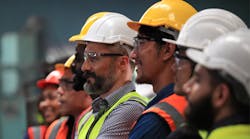Go and see: Take the first step to create a culture of reliability at your plant
As a leader, you must choose a small number of key initiatives or changes that you want to make on the business to deliver improved results. Leaders must keep in mind that in addition to the improvements they want to make, they need to also continue to “farm the farm” or run the business. To this end, a leader must be careful in selecting new actions, systems, and changes.
I have found the creation of a reliability culture to be, by far, the best change to maximize impact for the effort. A reliability culture not only impacts the reliability of the asset at the lowest possible cost, this culture drives improvement in production, quality, health, safety, environmental compliance, employee morale, and employee retention. Further and most often overlooked, is the impact reliability culture has on opportunity cost. Poor reliability consumes the attention and energy of the entire organization. What is possible if everyone had 20% more time to focus on the business, instead of simply trying to survive the day? Newfound process stability can fundamentally change your business.
I have worked in manufacturing for 36 years. I began as an engineer then transitioned to a maintenance manager, production manager, a global consultant, and a plant manager. I have worked closely with 44 different plants. In the process, I have found a universal truth regarding deploying reliability best practices on the path to creating a culture of reliability: If you do not have an expectation of “go and see” and use first-hand observation as a cornerstone of your culture, then you are doing reliability wrong. You will fail. Your results will be disappointing in both magnitude and time to realize.
Just as important: Why is this true?
Target the waste
You must understand that every reliability and maintenance best practice targets a waste. Examples of waste: process downtime, defects, reduced production rates, efficiency and effectiveness of people, reduced life of equipment, and all opportunity costs from instability. When the leader seeks to implement best practices, how do they decide where to begin?
Most begin as a result of key performance indicators (KPIs) and opinion from a conference room discussion. However, in reality, these only tell part of the story. KPIs often hide waste, and opinion are by nature biased. KPIs suffer from averaging. For example: If the life of a bearing is expected to be five years and the last three bearing failures have been at one, three, and 11 years, so the average for bearing life is five years—right on target! In this case, it is easy to see the waste and opportunity in each failure as individuals, but as a KPI it is hidden.
Opinion is even worse. I am not saying people lie; they just tend to leave out mistakes and events that may cause them embarrassment. For example, someone may have forgotten to lube a bearing upon installation only to remember to lubricate the next day. Then, the bearing fails prematurely. In summary, it is foolish to begin a reliability journey that targets waste elimination without intimately knowing the specific waste that exist in your plant. Further, leaders will not see the impact of best practice deployment if they do not see the waste being impacted on the factory floor leading to false conclusions.
First-hand observation culture
The good news is that a “go and see” culture with first-hand observation as a core competency is easy to achieve and can cost zero dollars to implement. Here are some behaviors in such a culture:
Every proposed change to a process, people, structure, and material shall be supported by at least 16 hours of direct observation on the shop floor at the appropriate spot.
After the morning meeting on Mondays, leadership goes to the shop floor to see any failures that have occurred in the last 48 hours. On Tuesdays, leadership audits two PM tasks being executed. On Wednesdays, leadership audits recent closed out corrective actions on the shop floor.
Every leader and staff employee is expected to spend four hours on the shop floor each week; this is noted on everyone’s electronic calendar.
In all meetings, the last agenda item is to go and see a change, problem, or solution on the factory floor.
Observation training is a requirement to begin, but this can be executed by internal resources who become subject matter experts from reading readily available information on waste. Actionable knowledge can be acquired in just hours and can begin to add observation to your data set in just days if not hours. I recommend specifically researching, “chalk circle observation” defined by Toichi Ohno. In my experience, observations need to be a minimum of four hours in duration at the point of the waste. I have observed current state wastes for as long as 15 days. Typical manufacturing plants require two to four days. Egos and time constraints are the primary reasons this step is nearly always skipped and why efforts fail.
Growing your data set and momentum
By adding observation to the data set of the leader, actions to take will become obvious and significant results will be sustainable, scalable, and rapidly achieved. If your team is stuck debating actions to take to drive reliability, there’s an excellent chance you do not have observation as part of your data set. Bottom line: you will make different decisions with observation as part of your data set; you will be more confident; and you will be right more often. This will create organizational momentum and enthusiasm. Congratulations; you are on “the road not taken” as Robert Frost stated. This path is the hidden best practice on your reliability journey.

